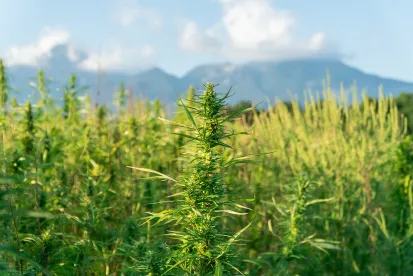The hemp-derived cannabinoid market continues to grow and evolve despite lingering questions over federal legality and numerous state laws that try to keep pace. Much has been written about new “legal” hemp products that contain intoxicating delta-8 THC, delta-10 THC and THC-O Acetate. This article, however, seeks to highlight a brazen new use for familiar old delta-9 THC. Edible products with intoxicating levels of delta-9 THC now are being sold as legal and less-expensive alternatives to regulated cannabis products. Although purveyors of hemp-derived delta-9 THC seek to exploit a perceived loophole in the 2018 Farm Bill’s definition of hemp extracts, these unregulated and intoxicating products are fraught with risk. The cannabis and hemp industries and their insurers should take notice and respond now.
Admittedly, there is some ambiguity in the Farm Bill’s definition of hemp extract because liquid extracts cannot be weighed on a dry weight basis (the Farm Bill’s definition of legal hemp extract includes “the plant Cannabis sativa L. and any part of that plant, including … extracts …, whether growing or not, with a delta-9 tetrahydrocannabinol concentration of not more than 0.3% on a dry weight basis”). Congress nevertheless clearly intended to make illegal any intoxicating products derived from legal hemp, based on a clear reading of the Farm Bill and its legislative background documents. We can therefore confidently say that intoxicating delta-9 THC products from hemp violate the spirit if not the actual letter of the law.
The Problem Illustrated
To illustrate the problem of hemp products that contain less than 0.3 percent delta-9 THC concentration but are nevertheless intoxicating, consider these examples. A typical energy bar of 60 grams would be allowed to have up to 180 mg delta-9 THC if limited to 0.3 percent THC concentration by weight. Regulated cannabis edible products, by comparison, typically may be sold only in a serving size of no more than 10 mg, with a limit of up to 100 mg per package. A four gram hemp gummy product, however, could have 10 mg of delta-9 THC and still fall below the allowable concentration threshold.
As States Race to Catch Up, California Announces a New Approach
As states grapple with how to respond effectively to the problem of unregulated intoxicating hemp cannabinoids being sold openly and online, some may choose to replicate California’s new approach announced within Assembly Bill 45 (AB45), which was signed into law by Governor Gavin Newsom in early October 2021. AB45 allows for hemp-derived cannabinoids, extracts and derivatives in food and dietary supplements with various restrictions. To curtail the growth of new intoxicating products such as delta-8 THC, the bill creates a new definition for “THC or comparable cannabinoid” that includes “[any] tetrahydrocannabinol, including, but not limited to, Delta-8-tetrahydrocannabinol, Delta-9-tetrahydrocannabinol and Delta-10-tetrahydrocannabinol, however derived.” The California Department of Public Health (CDPH) is granted discretion to include or exclude within this definition “any other cannabinoid, except cannabidiol, that the department determines … to cause intoxication.” This provides CDPH with the flexibility to respond quickly to new intoxicating hemp cannabinoid products sold within the state.
Total THC Caps and Serving Size Are Tricky Problems that Must Be Solved
As described in the examples above, food and beverages that contain less than 0.3 percent THC concentration may nevertheless be intoxicating due to the large amounts that may be consumed. AB45 recognizes this problem but leaves open the question of how CDPH will regulate maximum serving sizes, active cannabinoid concentration per serving size, the number of servings per container and similar questions that should help prevent intoxicating delta-9 products and similar abuses. The bill provides that CDPH “may regulate and restrict the cap on extract and may cap the amount of total THC concentration at the product level based on the product form, volume, number of servings, ratio of cannabinoids to THC in the product, or other factors, as needed.”
Cannabis and hemp industry leaders have warned against “percentage” thresholds of cannabinoids as an appropriate measure for foods and beverages for the reasons described above. California and other states will need to grapple with this issue, which should focus on the prevention of intoxicating hemp products sold as a legal and less-expensive alternative to regulated cannabis.
Inadequate Testing, Mislabeling and Fraudulent Lab Results Exacerbate the Risk
Intoxicating hemp-derived products add another level of hazard onto an already risky venture. Even non-intoxicating hemp products such as CBD and CBG generally have a higher risk profile than regulated marijuana for several reasons.
Due to the lack of strict testing requirements, hemp products have a greater frequency for and severity of product contamination compared with regulated cannabis products. Contamination may be caused by pesticides (as well as herbicides and fungicides), mycotoxins, solvents, heavy metals or microbiological contaminants.
Label inaccuracies and outright fraud also are pervasive within the hemp cannabinoid market. A recent survey by CBD Oracle, for example, found significant mislabeling and faked lab results for delta-8 THC products. Of the 51 products tested, 77 percent had less delta-8 than advertised and 76 percent contained delta-9 THC in concentrations greater than 0.3 percent, making those products indisputably federally illegal.
These products and others like them sold throughout the country are misbranded and adulterated products that subject the seller to possible civil abatement by regulatory authorities, liability under consumer protection statutes and potential criminal exposure.
Insurance Industry Recognition & Response
Insurers should take notice of this dangerous trend in the hemp cannabinoid market. Forms and underwriting procedures should be reviewed regularly to ensure that they adequately reflect the current underwriting intent for insureds that manufacture, distribute or sell hemp cannabinoid products. Due to the quickly evolving nature of this market, some insurers certainly have risk on the books from delta-9 THC hemp products and novel cannabinoid products that were not meant to be covered. Policy definitions, endorsements, exclusions and application questions should therefore be revisited and updated as needed.



 />i
/>i
